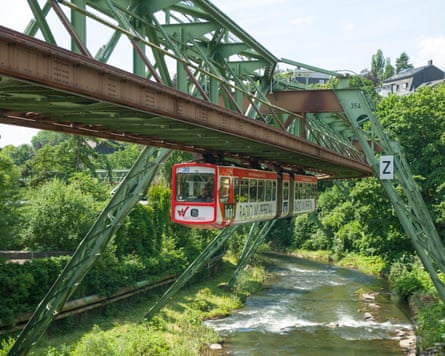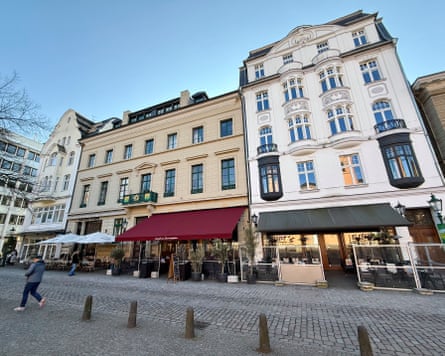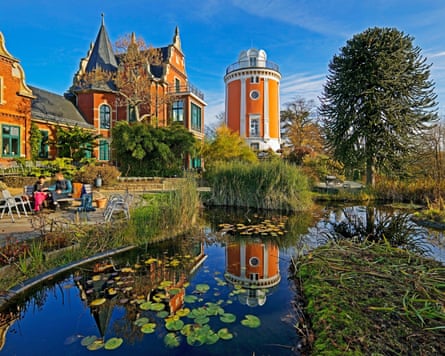It’s easy to be seduced by the romance of train travel. Think of sleeper trains, boat trains, vintage steam railways, elegant dining cars. But it’s rare that an urban transport system can capture the imagination quite as much as the Wuppertal Schwebebahn in Germany caught mine, and that of anyone else who’s clapped eyes on the world’s oldest suspended railway.
In October it will be 125 years since Kaiser Wilhelm II took a test ride in the Schwebebahn, just a few months before the hanging railway officially opened for business in March 1901. It was an incredible feat of engineering then, and remains so today. Even with sleek modern carriages having long replaced the original ones, it looks like something imagined by Jules Verne, with carriages smoothly gliding under the overhead track. They have even preserved the first 1901 carriage, nicknamed Kaiserwagen, which can be hired for private occasions.
A childlike feeling of glee filled me as I sat in the rear of the long carriage and watched the city reveal itself as I floated anything from 8 to 9 metres (26ft to 39ft) above it. At the railway’s westernmost end, Vohwinkel is the first of only four stations whose carriages run above the street, between iron arches. The rest of the railway, which in total runs for just over eight miles, follows the route of the river Wupper. As the hanging train curves and sways above the serpentine river, it turns this commuter service into something like a fairground ride for its 80,000 daily passengers. My hitherto unknown train geek had been unleashed and was utterly delighted.

The Schwebebahn came about almost by accident. The Wupper valley, about 15 miles east of Düsseldorf, was a major textile production base when Germany was undergoing its own Industrial Revolution in the 19th century. As workers flooded to the growing cities of Barmen and Elberfeld – which merged in 1929 and were renamed Wuppertal in 1930 – the authorities realised a public transport system was needed. Other cities were going underground, but Wuppertal’s rocky soil and narrow, steep valley made any sort of U-Bahn impossible, forcing the Schwebebahn’s inventor, Eugen Langen, to look up instead.
At Schwebodrom, the railway museum that opened in late 2023 near Werther Brücke station at the line’s eastern end, the rich history of the Schwebebahn is laid out in three galleries, revealing one fascinating detail after another. One gallery tells the story of Tuffi, a young circus elephant loaded into the Schwebebahn for a publicity stunt in 1950. Poor Tuffi was so spooked by jostling journalists that she bolted through a window and tumbled into the river. Luckily she was only lightly bruised and lived for another 49 years, her landing spot in the Wupper now marked by an elephant statue between Alter Markt and Adler Brücke stations. You can’t move in Wuppertal without seeing Tuffi on some souvenir or another – even on milk cartons.
Among the museum’s films and displays, the highlight for me was the reproduction of an original carriage, where I sat glued to my VR headset and found myself in 1920s Wuppertal. After riding the rails in real life, I was able to go back in time to see what had changed. Much of Wuppertal had to be rebuilt after heavy allied bombing in the second world war, and the railway itself has been completely reconstructed – including its art nouveau stations – while keeping the original steampunk-style design in the iron girders.

But there is a Wuppertal beyond the Schwebebahn, and this city of about 350,000 people was as full of pleasant surprises as its railway. Local guide Heike Fragemann took me to the tree-lined streets around Laurentiusplatz, a square dominated by the austere-looking 19th-century basilica of St Lawrence, dedicated to Wuppertal’s patron saint. Popular with many of the 23,000 students at the University of Wuppertal as well as people of all ages, the cosmopolitan streets hummed with cafes, delis, boutiques, bars and restaurants run by some of the many nationalities that have settled here over the decades – Italian, Turkish, Greek, Indian, Vietnamese and Spanish among them. In fact, the range of restaurants throughout the city was huge, and also included Lebanese, Chinese, Croatian and traditional German fare.
Pointing out an example of Wuppertal’s distinctive style of architecture – slate cladding, green shutters and white window frames – Heike led me along the narrow streets behind Laurentiusplatz as we steadily walked uphill. Not only was Wuppertal Germany’s Manchester because of its industry, Heike told me, but it was also compared to San Francisco thanks to its steepness. “We are the city of steps,” she said as we came to yet another one. “We have 500 staircases, more than 12,000 steps within the city. This is the most famous one.” She pointed to a sign with the captivating name of Tippen-Tappen-Tönchen, in honour of those 19th-century workmen clopping in their wooden clogs towards the riverside factories – hence the tipping-tapping sound. One to add to my list of adorable street names.
after newsletter promotion

It was the wealthy 19th-century industrialists who shaped the city, not just with their comfortable hillside villas, but also with Wuppertal’s cultural institutions. The Von der Heydt Museum, named after an art-collecting banking family, houses its impressive collection of 19th- and early 20th-century art in what had been the neoclassical town hall. The entrance is flanked by two large sculptures by the Liverpool-born Turner prize-winner Tony Cragg, who made Wuppertal his home in 1977. The Historische Stadthalle concert hall, marking its 125th anniversary this year, had Richard Strauss as one of its first conductors and Sir Simon Rattle rated its acoustics among the best in the world. Public gardens fill many of the gaps in the city, including the vast hilly Botanical Garden.
As I sat in the warm, bookish surroundings of Café Engel in Laurentiusplatz, I was reminded of Friedrich Engels, the son of a wealthy Wuppertal textile manufacturer, who turned his back on his bourgeois background to co-author The Communist Manifesto with Karl Marx after seeing the appalling working conditions in mid-19th-century Manchester. Engels died in London six years before the Schwebebahn opened, and it was many years earlier that the city’s industrialists had already implemented social reforms for working-class residents that were ahead of their time. The Schwebebahn, too, looks like something from the future, but its story is purely of Wuppertal’s unique past. Here, in Germany’s old industrial heartland, the high life is yours from €3.60 a ticket.
This trip was provided by the German tourist board and Le Shuttle, which has return fares from Folkestone to Calais from £155 per vehicle. Further information at wuppertal.de. Doubles at Holiday Inn Express Wuppertal Hauptbahnhof (some with views of the Schwebebahn), start at £79B&B. Schwebebahn 24-hour tickets €8.80, and €4.40 for additional passengers. Schwebodrom adults tickets €16.50

 3 months ago
46
3 months ago
46

















































